Developments since 2016
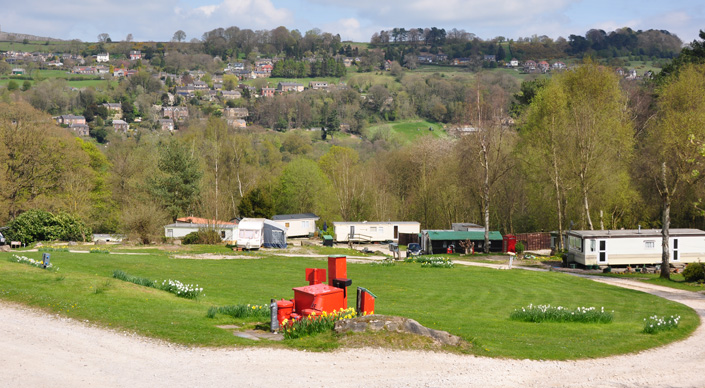
Country Wide Park Homes (CWPH), a company owned by Mr & Mrs A. Barney, bought the site from the George family and registered it as Haytop Country Park Ltd. Thus Haytop Park became part of a portfolio of similar sites owned by the Barney family, scattered across the UK.
Eviction of caravan owners
In February 2017 the existing caravan owners at Haytop were given eight days notice to quit(1), later extended to 28 days. They were told that the site was no longer licenced and that their caravans had to be removed so the service facilities could be upgraded. Some owners succeeded in finding alternative locations for their caravans but others were forced to abandon them on site, where they were subsequently destroyed. CWPH had adopted similar tactics elsewhere to clear a newly acquired site of its occupants (2) and Mr Barney’s methods and treatment of caravan owners had featured in a parliamentary debate as long ago as 2009 (3).
Illegal tree felling to clear the site
On Friday17th March residents in Whatstandwell, across the valley from Haytop, noticed that trees in the park were being felled(4) and informed the Amber Valley Borough Council (AVBC) Tree Officer of that. He promptly visited the park and told the contractor that all trees on the site were subject to a Tree Preservation Order (TPO). He ordered them to stop the felling. That was ignored and the contractors continued to destroy many trees over the weekend. On 22nd March an injunction which could result in fines or prison sentences was obtained by AVBC and that put a stop to the activities. Meanwhile, a lot of the wood was burned or put through a chipper, while some stumps were removed with a JCB. Fortunately council and Forestry Commission personnel were able to map the position and species of many of the felled trees by examining the stumps and debris.
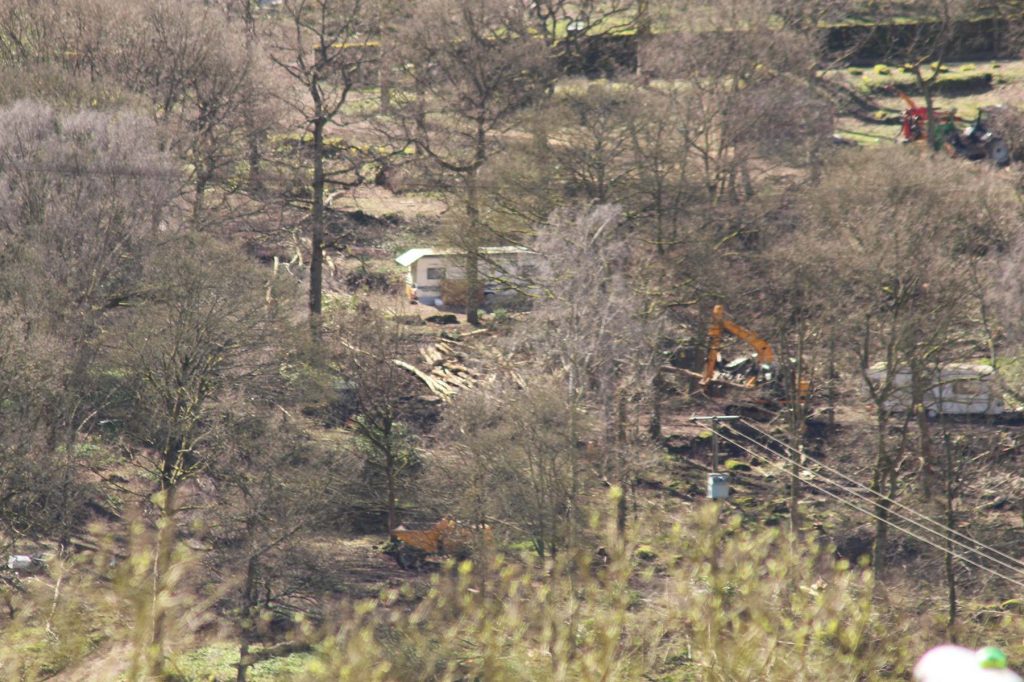
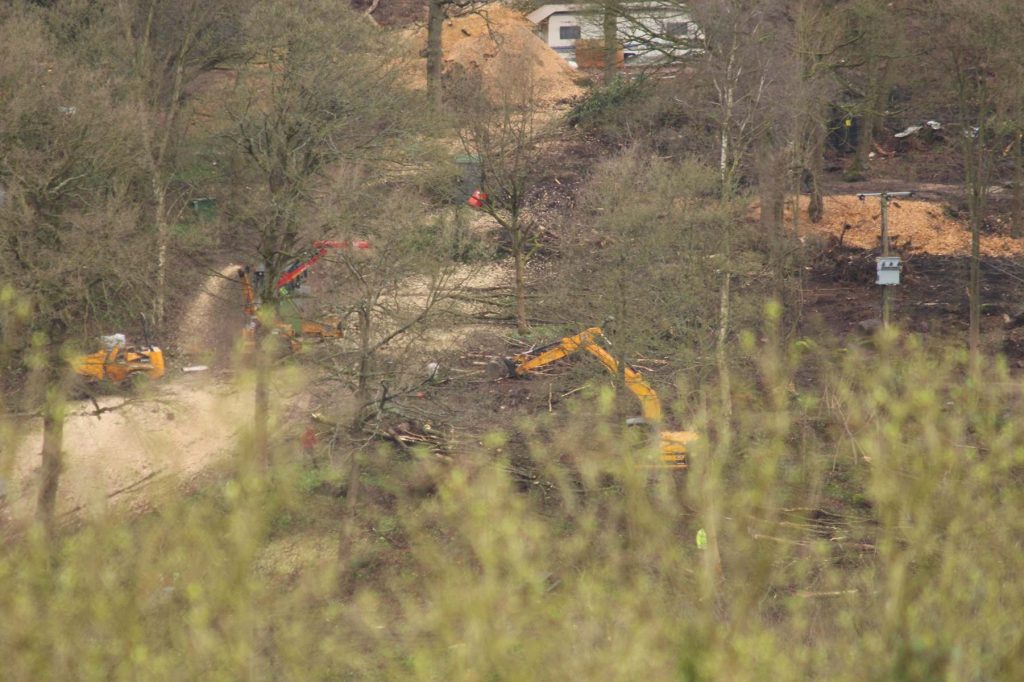
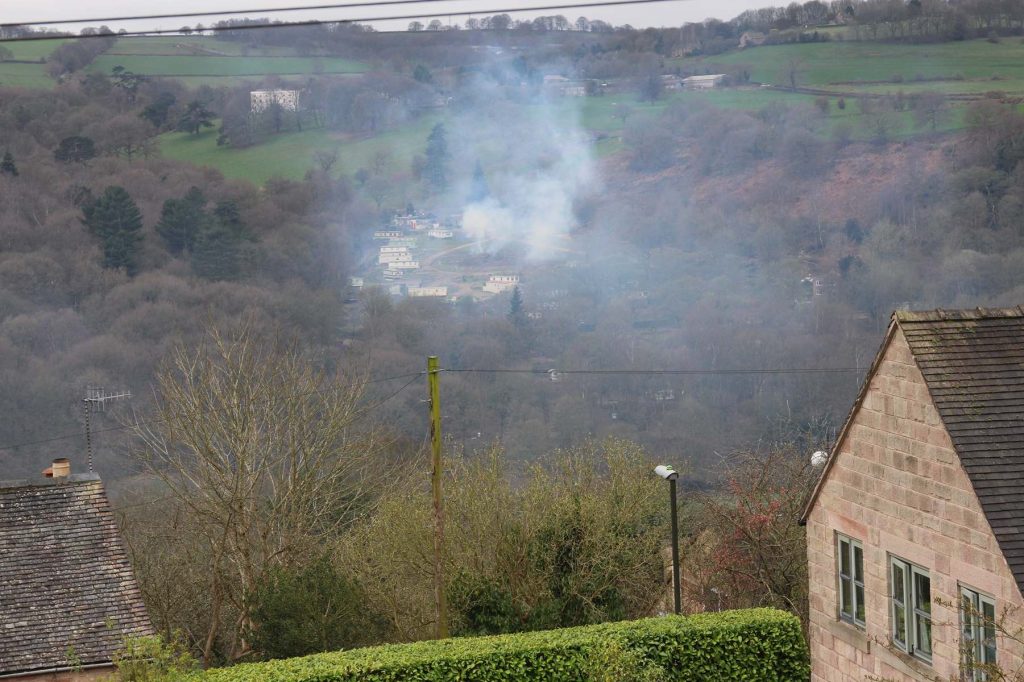
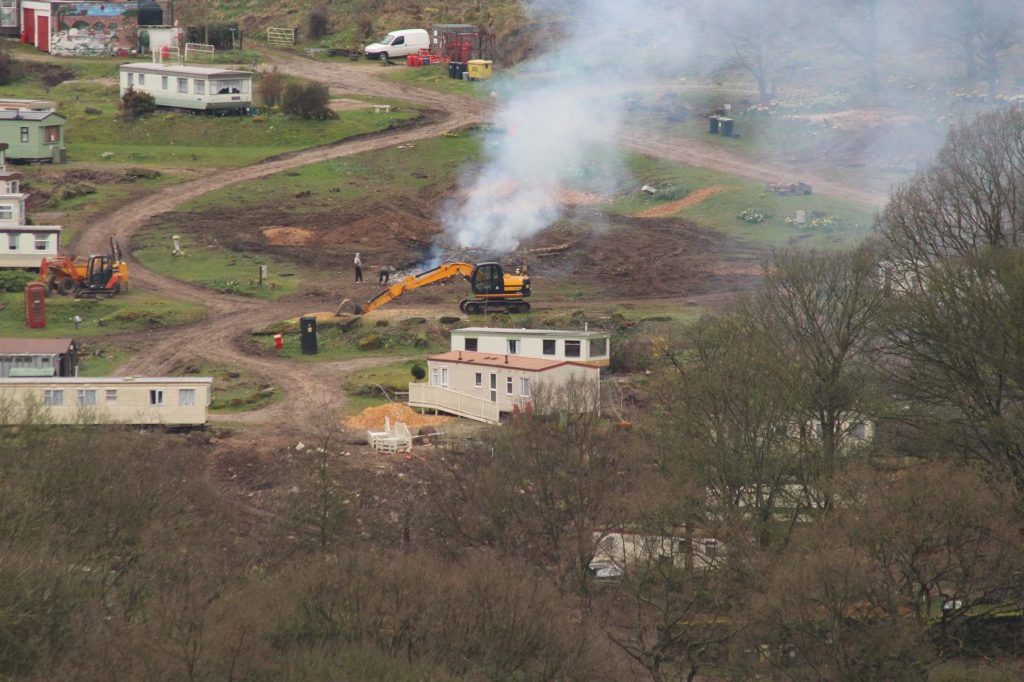
Later in the year the company and its contractors pleaded guilty in court to having illegally destroying more than 120 trees on the site. They were fined £3000(5), an insignificant amount when considering the assets of Haytop Park’s owners. More trees were damaged after that, resulting in a further fine. There is a requirement to plant an equivalent number of trees to replace those destroyed but that has not yet been done.
Meanwhile an application submitted to AVBC for use of Haytop as a caravan site for permanent living accommodation was refused in April 2017.
The Central Green Recreational Area
Condition 9 of the 1966 planning permission states that “The central green on the site shall be maintained permanently open as a recreational area and neither tents, caravans nor buildings shall be permitted to be sited thereon.”

In May 2017 an application was made to allow an unspecified number of touring caravans on the green. The applicant claimed that caravans had been continuously on the area for a period of 10 years before 2016 but failed to provide proof of that. Several objections from local residents and organisations were submitted to AVBC, who refused the application in July. Despite that the owner carried out more earthworks to terrace the area and laid concrete slabs on which to place lodges. The council issued a Stop Notice in September followed in October by a Breach of Conditions Notice (ENF/2017/0171) to halt the works and return the area to its original state by 11th November. Both were ignored and a lodge was installed on the green on 6th November.
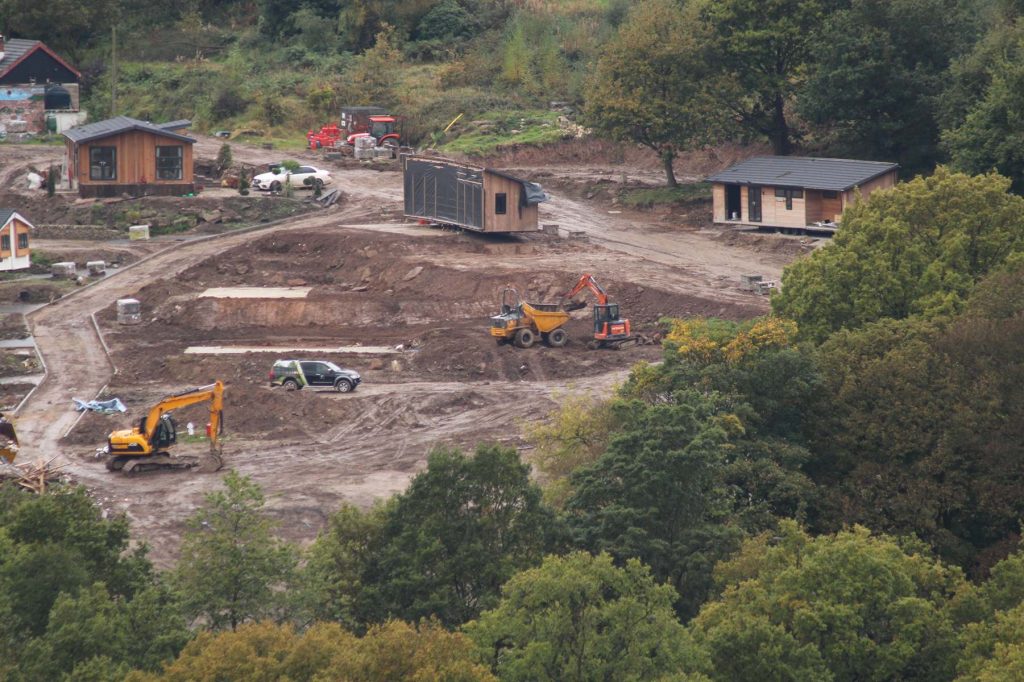
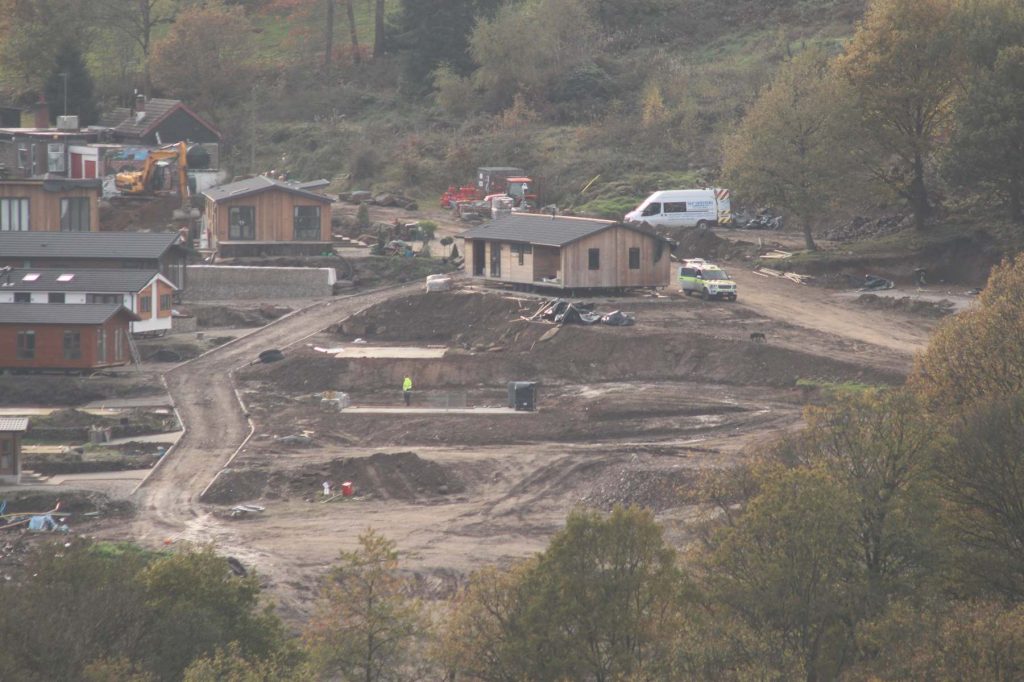
Faced with the possibility of further court action the developer eventually removed the lodge and dug up the concrete slabs in November 2018. He started to bury the broken concrete in situ but that was reported to AVBC, who insisted that the material was removed from the site. The area was re-profiled to a gentle slope, more then a year after it should have been.
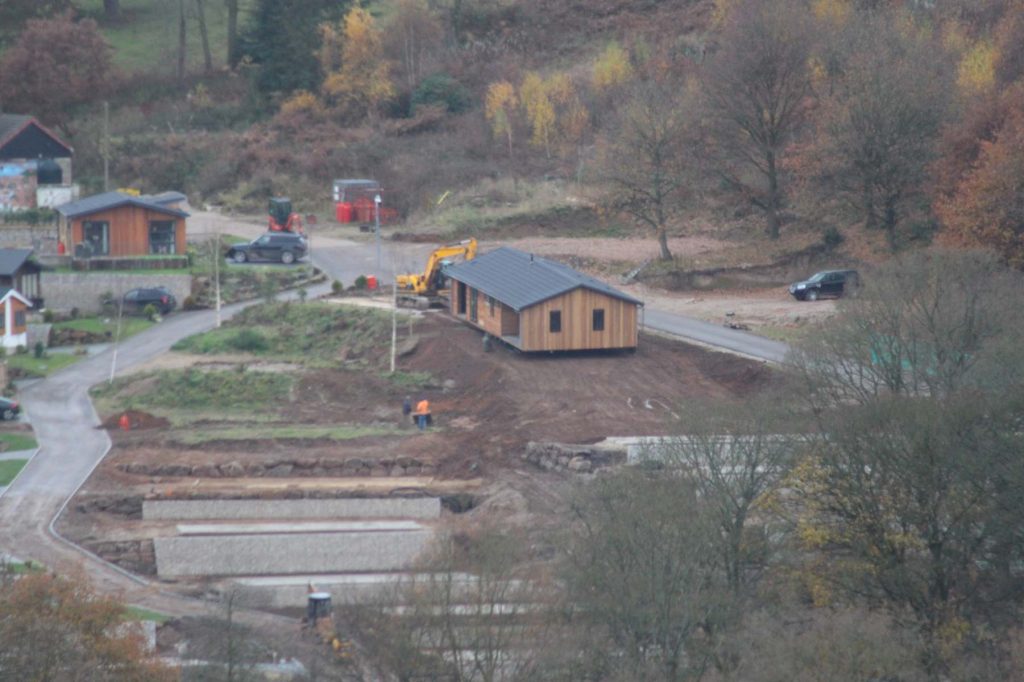
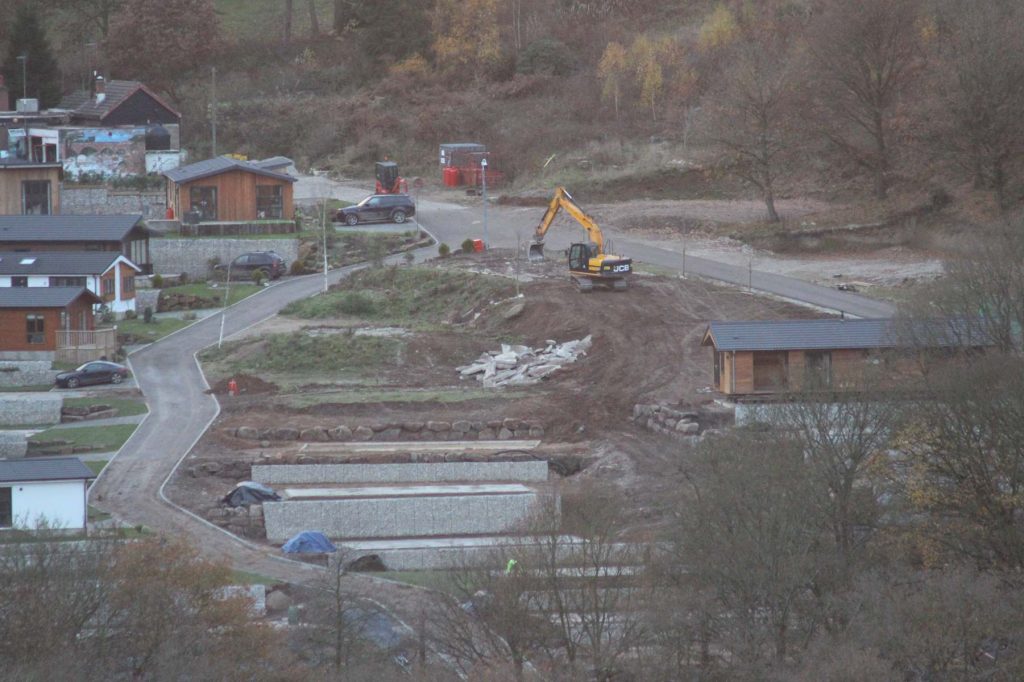
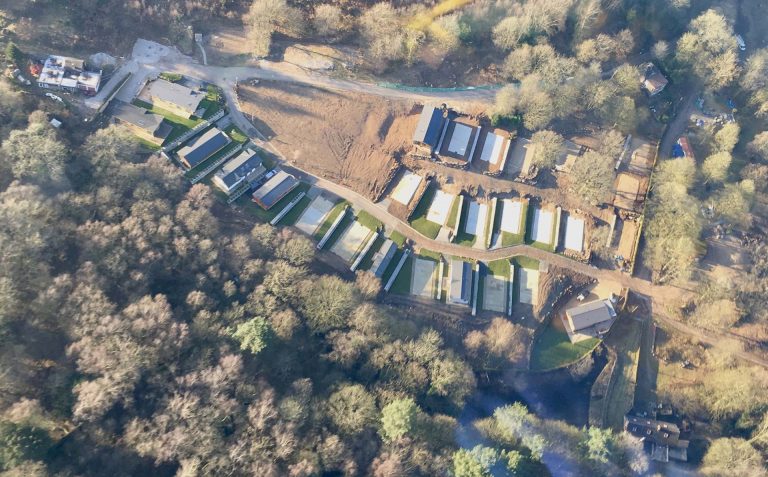
Application ref. AVA/2017/1336 for a change of use from 30 caravans for seasonal use to 11 lodges for residential use.
(See:- https://www.ambervalley.gov.uk/planning/development-management/view-a-planning-application/ and enter the reference AVA/2017/1336 for details)
This was submitted in December 2017 and has since been modified by the applicant but remained essentially as stated. A decision was repeatedly postponed but the application was withdrawn on 17th April 2019 at the request of the applicant to enable the proposals to be reconsidered
Details
The application sought to put 11 permanent residential lodges in an area where previously there were small touring caravans screened from public view by trees. If approved, many of those trees would have had to be removed to allow for the placing of the lodges. Furthermore, there would be “associated infrastructure” (presumably hard surfaced roads and concrete slabs) and site-wide street lighting where there was none before. The application was worded in such a way that could be misleading because it asserted that permission already existed for 30 residential lodges, so the total would be 41 not 11. That assertion was questionable and disputed by WACAG and others (see later explanations).
Public Response & Reactions
This application generated a lot of correspondence with AVBC, together with numerous objections. A local petition gathered more than 450 signatures, representing over 90% of the adult population of Whatstandwell and Alderwasley. There were objections from various organisations such as Derwent Valley Mills World Heritage Site Partnership, Natural England, Campaign to Protect Rural England, Derbyshire Wildlife Trust and both Crich and Alderwasley Parish Councils. In response to representations from members of the public Borough Councillors and the local MP also contacted AV Development Management about the matter.
More than 70 objection comments have been sent to AV Planning. They emphasise disturbance to the environment and wildlife in the World Heritage Site buffer zone which includes the conservation area wherein Haytop lies as well the adjacent Shining Cliff Wood, an SSSI part-owned by The National Trust. Other concerns relate to potential increased accident risk on the A6 trunk road and pollution risk to the River Derwent because foul water disposal cannot be connected to a main sewer. Widespread street lighting would create much light pollution where there was darkness before.
The company claimed that the development and lodges would not have a significant impact on the views in the area. Anyone looking at the site from the A6 road, the Derby-Matlock railway line, the Cromford canal, Whatstandwell village or various public footpaths on the east side of the Derwent valley would almost certainly disagree.
It is perhaps worth recalling that the council approving the 1966 planning permission stated that the site is “of great scenic importance” in “an area of great landscape value” and it is the aim of the local authority “to protect the area’s scenic attractiveness“.
The legal situation regarding planning permissions.
We were concerned about the developer’s apparent lack of regard for planning permission conditions. In particular, it seemed to us that the existing permissions allowed for permanent residence only in trailer type caravans. Other types of caravan, including lodges, are restricted to seasonal use. The developer claimed otherwise and AVBC had not insisted on those controls.
WACAG members and others were therefore not entirely happy with responses from AV planning department. We decided to seek advice from elsewhere and made contact with another group who had objected to a similar proposed development by Mr. Barney in Hampshire(6). They had used the services of a leading planning barrister, Paul Brown Q.C. at Landmark Chambers, London, to contest an application by CWPH Ltd to change the use of a camping/caravan park similar to Haytop from seasonal holiday use into a residential park. So, in the absence of clear information from the council, WACAG commissioned a Legal Opinion from Mr Brown which we received in July 2018. He agreed that two Permissions are still in force. The 1952 Permission does not restrict the nature of occupation but the type of caravan must be of the “trailer” type, designed to be towed by a motor car. Such caravans could therefore be used year-round. On the other hand, there is no restriction as to the type of caravan which can be stationed at Haytop under the 1966 Permission. However, condition 5 of that Permission restricts their use to “seasonal” and specifically forbids permanent occupation. It also states in the Permission that “the site is not felt to be suitable for use as a permanent residential caravan site.”
Counsel also suggested that there are distinct dangers in dealing with Haytop on a piecemeal basis and recommended that AVBC should encourage the owner to bring forward a comprehensive scheme which explains what he intends to do. If that does not happen there is a very real risk that AVBC will find that anything it has allowed is the “thin end of the wedge”.
Subsequently, in October 2018, the council suggested that the applicant should withdraw AVA/2017/1336 and submit a comprehensive application for the whole site. He did not do that.
Unlawful occupancy
The Q.C’s Opinion clearly supports WACAG’s view that no lodge can be used as a permanent residence. Anyone wishing to live all year round at Haytop must do so in a trailer type caravan.
WACAG accepts that the 1966 Permission does allow lodges to be on site, but only for “seasonal occupation”. While “seasonal” was not defined in the 1966 Permission, the site licence issued in 1968 does state that it is the period between 1st April and 30th September. It is our view, and that of Counsel, that most reasonable people would not define “seasonal” as being continuous for 12 months of every year. Nevertheless, some lodges have been permanently occupied for a year or more, are registered for Council Tax and receive postal deliveries. Furthermore, council officials agree that some lodges are permanently occupied. On several occasions since September 2018 WACAG has sought an explanation from AVBC as to why these planning permissions and conditions have not been enforced.
Misleading advertisements?
During 2017 and 2018 lodges were advertised for sale at Haytop Park on the Country Wide Park Homes website and by several estate agents. The park was described as having been redeveloped, being residential and having shops and a tea-room, none of which was true. Derbyshire Trading Standards and the Advertising Standards Authority both required CWPH to modify their advertisements to make it clear to prospective buyers that there is uncertainty regarding the use of lodges as permanent residences.
In 2019 Mr Barney acquired The Dream Lodge Group. He registered a new company, Exclusive Luxury Lodges, which trades as The Dream Lodge Group and CWPH seemed to no longer exist for a while. Adverts on The Dream Lodge Group website claimed that Haytop is a residential site and lodges were available for purchase. Once again, Derbyshire Trading Standards and the ASA contacted the company to remind them of their responsibilities to make clear to prospective consumers the outstanding issues with regard to planning permission at the site.
It may be worth noting that the following information appeared on the Dream Lodge website:
“The countrywide Park Homes 100% market value part exchange promise comprises of 3 Simple, Quick and hassle-free steps.
- We’ll arrange a local estate agent to visit your home and carry out a valuation
- We’ll give you a written offer
- We’ll handle everything else for you.”
This appears to invite buyers to sell their existing home in order to finance the purchase of a lodge. It is probably a reasonable assumption for such a buyer to think that they were purchasing a permanent residence under these circumstances.
Some lodges at Haytop have been occupied for more than 18 months, and those lodges are designated as “sold” on the website. That suggests that some individuals may have made a transactional decision but it is unclear as to whether they were made aware of the planning conditions that restrict lodges to seasonal use before making their purchase. If it is finally determined that lodges can be used only for seasonal occupation those residents could be faced with an unpleasant surprise and eviction.
Other planning applications
TRE/2018/0377 was an application to remove four apple trees from the old orchard. In the supporting documents the applicant stated that the trees were not unhealthy or dangerous. Furthermore, in an Environmental Impact Assessment submitted in support of AVA/2017/1336 the applicant stated that the existing orchard trees should be retained, so the application seemed to be inconsistent with the EIA. There were several objections submitted to AVBC but the application was nevertheless approved in December 2018. There is a requirement to plant replacement trees.
AVA/2018/1068 is an application to demolish a bungalow which had been a family residence and later the home of the site manager. In the supporting documents it was stated that the bungalow was “largely in disrepair”. However, this is contradicted by a statement made by the same consultants in a recent bat survey that “the building is in a good state of repair”. Several objections have been submitted to AVBC and, critically, Derbyshire Wildlife Trust (DWT) has reminded the council of its obligations with regard to the possible presence of protected species, i.e. bats. (Ref. https://www.ambervalley.gov.uk/planning/development-management/view-a-planning-application/ , Application no. AVA/2018/1068, document 931138). DWT have asked that another survey be done during the active bat season and perhaps because of that the decision date for the application was postponed until June 2019.
References
(1) – https://www.derbyshiretimes.co.uk/news/caravan-owners-given-eight-days-to-leave-site-1-8426672
(3) – https://publications.parliament.uk/pa/cm200809/cmhansrd/cm090302/debtext/90302-0022.htm
(4) – https://www.bbc.co.uk/news/uk-england-derbyshire-39342491
(5) – https://www.derbytelegraph.co.uk/news/local-news/caravan-park-firm-fined-3k-891797
For recent developments and updates see our Blog and Documents pages.